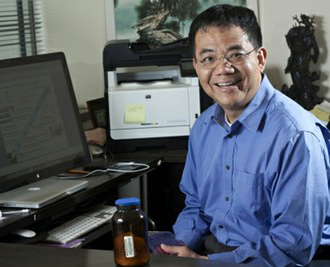Yang Yang's LCD Panels Generate Electricity
Yang Yang's polarizing organic photovoltaic may solve the problem of depleted batteries in portable electronics.
Yang Yang may have solved one of the biggest problems faced by users of mobile devices like smartphones and tablet PCs — depleted batteries. A new type of LCD developed by Yang not only dramatically cuts energy use but actually acts as a photovoltaic cell to recharge the battery.
A photovoltaic polarizer developed by Yang Yang’s team at the UCLA Henry Samueli School of Engineering and Applied Science lets LCD panels double as solar cells, converting ambient light, sunlight and even their own backlight into electricity.
Today’s LCDs are energy hogs. They use two polarized sheets that collectively let only a small amount of the backlight pass through, wasting up to 75 percent of the energy used by the backlight. The polarizing organic photovoltaic invented by Yang’s team acts simultaneously as a polarizer, a photovoltaic device and an ambient light or sunlight photovoltaic panel.
“I believe this is a game-changer invention to improve the efficiency of LCD displays,” said Yang Yang, a professor of materials science and principal investigator on the research. “In addition, these polarizers can also be used as regular solar cells to harvest indoor or outdoor light. So next time you are on the beach, you could charge your iPhone via sunlight.”
The display’s backlight uses up to 80 to 90 percent of the power used by a mobile device. Yang’s polarizing organic photovoltaic LCD could save much of that unused energy, as well as convert about 4% of the solar or ambient light energy that hits the LCS into electricity for recharging the battery.
Yang is currently at work increasing the efficiency of the polarizing organic photovoltaic with an eye toward working with electronic manufacturers to integrate the technology into products. Improving the likelihood of the invention being adopted commercially is that simplicity of the coating method.
“The polarizing organic photovoltaic cell demonstrated by Professor Yang’s research group can potentially harvest 75 percent of the wasted photons from LCD backlight and turn them back into electricity,” said Youssry Botros, program director for the Intel Labs Academic Research Office, which supported the research.
Yang’s research was also supported by the Office of Naval Research. Their research study is available in the online edition of the journal Advanced Materials and will be published in its upcoming print edition.
Yang Yang earned a BS in physics from the National Cheng-Kung University in Taiwan in 1982. He then received a masters and PhD in physics and applied physics from the University of Massachusetts, Lowell in 1988 and 1992, respectively. He worked on the research staff of UNIAX (now DuPont Display) in Santa Barbara from 1992 to 1996.
Yang joined the UCLA faculty in 1997 and is now the Carol and Lawrence E. Tannas Jr. Endowed Chair Professor of Materials Science and Engineering. He is a materials physicist with expertise in the fields of organic electronics, organic/inorganic interface engineering, and the development and fabrication of related devices, such as photovoltaic cells, LEDs, and memory devices.
In the field of organic photovoltaics Yang has contributed to an enhanced understanding of polymer morphology and its influence on device performance. He has also invented the inverted organic solar cell, the inverted tandem solar cell, and photovoltaic polarizers for LCD applications.
His work has been recognized by the Science Watch list of Top 11 Hot-Researchers in 2010. He had the highest cited paper in 2010 in Advanced Functional Materials and the highest cited paper in 2008-2010 in the Journal of American Chemical Society (JACS).

Yang Yang is a UCLA materials science professor who has invented an energy-producing polarizing organic photovoltaic coating for LCD panels.

